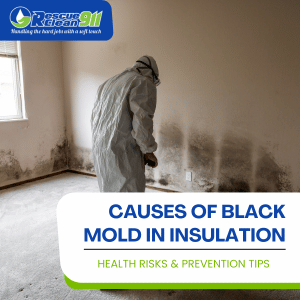If you notice fungi appearing in your shower, on window sills, or even on ceilings, it’s crucial on how to identify mushrooms growing in bathroom immediately.
Bathrooms provide an ideal environment for fungi due to excess moisture, high humidity levels, and poor ventilation. Acting quickly not only protects your home but also prevents potential health risks associated with fungal growth.
Mushrooms in bathrooms are not just unsightly. They can indicate serious underlying moisture problems that may lead to mold growth, structural damage, or even exposure to toxic fungi.
This guide will help you understand why mushrooms appear, how to identify them, remove them safely, and prevent future growth.
How to Identify Mushrooms Growing in Bathroom?
Several factors, such as high heat, excess moisture, and low light, provide the ideal growing conditions for mushrooms.
These factors enable mushrooms to thrive on bathroom floors, tiled walls, window screens, nylon shower curtains, and even ceilings, particularly in areas where moisture accumulates or pools.
Another factor is that you may have rotten wood in your bathroom. Identifying mushrooms is crucial for safety and proper removal. Key steps include:
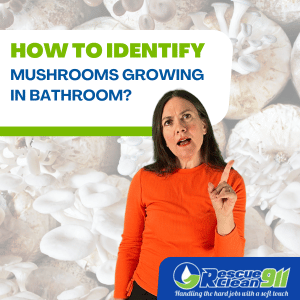 Observation: Look for clusters or solitary mushrooms. Many bathroom fungi grow in groups, while some may appear alone. Take note of size, color, and texture.
Observation: Look for clusters or solitary mushrooms. Many bathroom fungi grow in groups, while some may appear alone. Take note of size, color, and texture.Spore Print: Creating a spore print from the mushroom cap is a reliable method for identification. Each species releases unique mold spores that can help determine whether it’s toxic mushrooms or non-toxic mushrooms.
Research and Expert Consultation: Use field guides, online forums, or mycologists to accurately identify mushrooms growing. Never consume unknown mushrooms.
Check the Surrounding Area: Many mushrooms indicate hidden leaks or underlying moisture problems, which must be addressed to prevent recurrence.
Remember, many fungi found in bathrooms are more common molds than true mushrooms, and they signal moisture issues rather than being inherently dangerous.
Discover whether high heat can effectively kill mold and what temperatures are required for remediation.
Why Do Mushrooms Grow in Bathrooms?
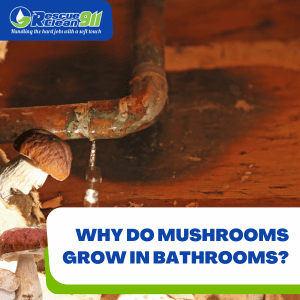 Mushrooms grow in areas that provide a perfect environment: damp, warm, and poorly ventilated spaces. Bathrooms, unfortunately, meet all these criteria. Some key factors that promote fungal growth include:
Mushrooms grow in areas that provide a perfect environment: damp, warm, and poorly ventilated spaces. Bathrooms, unfortunately, meet all these criteria. Some key factors that promote fungal growth include:
Excess moisture from showers, baths, and sinks
High humidity levels in confined spaces
Poor ventilation prevents air circulation
Leaking pipes or unnoticed water leaks
Presence of organic materials like wooden cabinets, paper products, or even soap residue
Mushrooms are opportunistic and can thrive in bathrooms if left unchecked. Bathrooms are often ideal breeding grounds for fungi because mold spores travel through the air and settle on damp surfaces, initiating further growth.
Health Risks of Bathroom Mushrooms
 Visible mushrooms indicate moisture problems and fungal growth, which can contribute to:
Visible mushrooms indicate moisture problems and fungal growth, which can contribute to:
Respiratory issues from inhaled spores
Allergic reactions such as skin irritation, sneezing, or asthma flare-ups
Exposure to highly toxic mushrooms in some cases
Black mold growth, which further compromises the bathroom environment
It’s essential to avoid direct contact with mushrooms and wear protective gear, such as gloves and masks, when handling them. Some mushrooms also emit a foul odor, which can signal toxic varieties.
Related article: How To Get Rid of Mushrooms Growing on Carpet
Common Types of Mushrooms Found in Bathrooms
Mushrooms grow in various environments, so it’s not surprising that some might start growing in your bathroom. Unfortunately, identifying mushrooms growing in your bathroom can be difficult, as many look very similar.
However, with a little bit of research and some close observation, you should be able to determine which types of mushrooms are growing in your bathroom.
Some of the most common types include:
Cladonia Rangiferina (Reindeer Moss)
Small, white mushrooms growing on damp surfaces. One of the most common types of mushrooms found growing in bathrooms is the Cladonia rangiferina, also known as reindeer moss.
This type of mushroom is small and white and typically grows on damp surfaces. If you see a group of small, white mushrooms growing in your bathroom, chances are they are reindeer moss.
Coprinus Comatus (Shaggy Mane)
Larger mushrooms with brownish-white caps. This mushroom is larger than the reindeer moss and has a brownish-white cap.
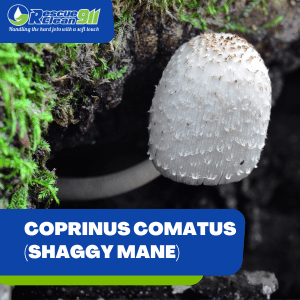 The shaggy mane typically grows on damp surfaces as well, so if you see a large mushroom with a shaggy cap, it is probably a shaggy mane.
The shaggy mane typically grows on damp surfaces as well, so if you see a large mushroom with a shaggy cap, it is probably a shaggy mane.
Many other molds and fungi thrive in humid environments, forming fuzzy or slimy patches.
Mold spores travel easily through the air, settling in ideal environments like tile grout, wooden cabinets, or shower curtains. Noticing mushrooms early helps prevent them from promoting fungal growth elsewhere.
If you are still unsure about which type of mushroom is growing in your bathroom, you can try to identify it by its fungal spores. Mushrooms release spores into the air, which can then be observed under a microscope.
Each type of mushroom has unique spores, so by observing the spores of the mushroom growing in your bathroom, you may be able to identify it.
Suppose you are still having trouble identifying the mushroom. In that case, you can always take a sample to a local Mushroom Club or a mycologist for identification.
You can also contact Rescue Clean 911 at 561-782-1392 for better assistance. We are experts in mold removal and more. We are reliable and trustworthy to remove mushrooms growing in your bathroom.
How to Remove Mushrooms Safely
If you have mushrooms growing in your bathroom, don’t panic. There are a few things you can do to get rid of them. With a little effort, you should be able to rid your bathroom of these pesky fungi in no time. Handling bathroom mushrooms requires caution:
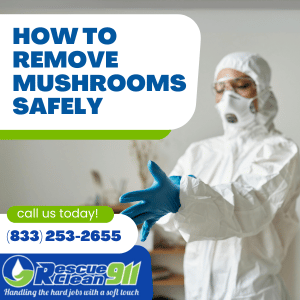 Wear Protective Gear: Gloves, masks, and eye protection are essential to avoid direct contact with spores.
Wear Protective Gear: Gloves, masks, and eye protection are essential to avoid direct contact with spores.Manual Removal: Use a damp cloth or brush to remove mushrooms physically. Avoid crushing them, which spreads spores.
Disinfect: Apply a mold-killing solution or natural remedies, such as vinegar, to the affected area. Rinse thoroughly afterward.
Address Hidden Moisture: Check for leaks, water leaks, or damaged tiles. The presence of fungi often indicates a serious underlying cause.
Dehumidifiers and Ventilation: Controlling humidity levels and ensuring proper ventilation are crucial. Use exhaust fans or open windows to maintain a dry bathroom environment.
Avoid leaving mushrooms unattended. Even non-toxic mushrooms can signal damp conditions that encourage mold growth and structural damage.
Related article: Is Mold On Pipes a Cause For Concern?
Preventing Future Mushroom Growth
When you notice mushrooms growing in your bathroom, take immediate action by removing them and ensuring they do not grow further. To prevent mushrooms from growing very often, you’ll need to identify the root cause and fix it.
 To prevent mushrooms from growing in your bathroom, follow these strategies:
To prevent mushrooms from growing in your bathroom, follow these strategies:
Control Humidity: Use exhaust fans, open windows, and consider a dehumidifier to reduce humidity levels.
Fix Leaks Promptly: Address leaking pipes, dripping faucets, or water intrusion immediately.
Clean Regularly: Wipe down surfaces after showers to remove moisture buildup.
Inspect for Hidden Moisture Problems: Regular inspections help detect breeding grounds before mushrooms appear.
Promote Air Circulation: Proper ventilation discourages mushrooms from growing in damp corners or behind furniture.
Avoid Organic Build-Up: Paper towels, wooden materials, and soap scum can serve as ideal environments for fungi.
By implementing these strategies, you can prevent recurrence and maintain a safe and healthy environment. If you have any questions or concerns, please contact your local professional for assistance.
Discover the typical duration of mold remediation, including key factors, processes, and expert tips to ensure effective removal.
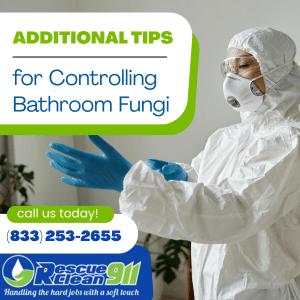 Additional Tips for Controlling Bathroom Fungi
Additional Tips for Controlling Bathroom Fungi
Regular Bathroom Maintenance: Inspect bathrooms weekly to find mushrooms or potential mold issues early.
Use Mold-Resistant Products: Consider using grout, caulk, and paints designed to resist mold and fungal growth.
Address Structural Issues: Persistent mushrooms often point to hidden water leaks or insufficient insulation. Fixing these helps prevent future growth.
Avoid Direct Contact: Always wear gloves when handling fungi to prevent health issues.
Educate Household Members: Teach everyone to wipe surfaces dry and report leaks promptly.
Natural Remedies for Mushroom Removal
Natural methods can be highly effective for smaller infestations:
Vinegar Solution: Spray vinegar on affected areas to kill surface fungi and spores.
Baking Soda: Helps absorb moisture and creates an environment less conducive to growth.
Sunlight: Open windows to reduce humidity levels and slow further growth.
These methods work best in conjunction with manual removal and addressing the root cause of moisture buildup.
Signs You Need Professional Help
If you notice:
Mushrooms appear repeatedly despite cleaning
Foul odors coming from hidden water leaks
Mold or black patches are spreading rapidly
Structural damage caused by moisture
Mushrooms are growing in your bathroom, and you don’t know what to do!
Don’t worry, we’re here to help. We will prevent it from spreading widely in your bathroom. Rescue Clean 911 is a 24/7 specialist in biohazards, mold (including black mold), fire, and more.
You’ll be able to get rid of those pesky mushrooms in no time at all, which may cause allergic reactions.
Visit our website to learn more or call us at 561-782-1392. We will be happy to assist you!
Key Takeaways!
Identifying and handling mushrooms in your bathroom requires care, attention, and proactive prevention.
By taking the steps outlined in this guide—wearing protective gear, removing mushrooms, addressing moisture problems, and maintaining proper ventilation—you can maintain a healthy environment and prevent further growth.
Remember, the presence of mushrooms is often a sign of hidden issues that need immediate attention.
The sooner you act on how to identify mushrooms growing in bathroom, the better you protect your home, your family’s health, and your property from long-term damage.
FAQs About Mushrooms in Bathroom
While most indoor mushrooms aren't dangerous to the touch, their presence is a clear sign of excessive moisture, which creates conditions for harmful mold.
Mushrooms grow due to high humidity, moisture buildup, and poor ventilation. They often signal leaks or damp areas that need fixing.
Mushrooms in pots indicate overly wet soil. They’re usually non-toxic but can promote fungal growth harmful to plants if not removed.
Bathrooms often have mold, mildew, and other fungi on tiles, grout, and curtains. They thrive in damp conditions and may accompany mushroom growth.
Not always, but mushrooms often appear with mold, both caused by excess moisture. Their presence signals a need to fix underlying water issues.

